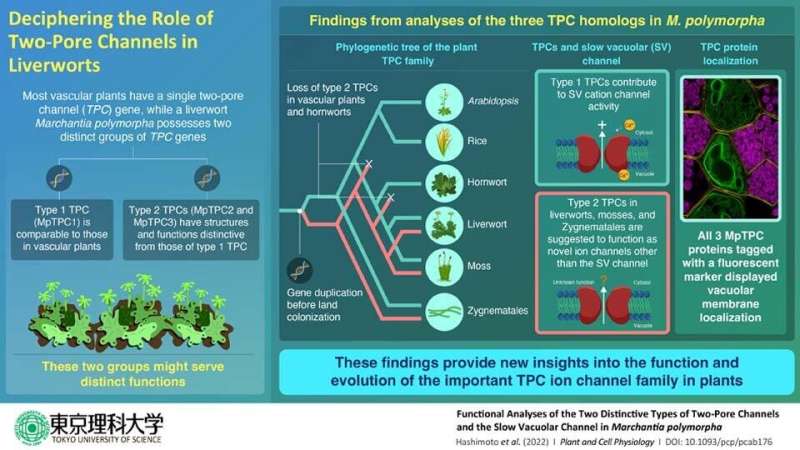Lighting the tunnel of plant evolution: Scientists explore the importance of two-pore channels in plants

Two-pore channels (TPCs) are ancient ion channels present in the cells of both animals and plants. In animals, including humans, these ion channels play important roles in biological activities in various tissues, such as in the brain and nervous system. All land plant species contain TPC genes; in many higher vascular plants such as Arabidopsis thaliana (Arabidopsis) and Oryza sativa (rice), a single TPC gene is involved in the activity of slow vacuolar (SV) channels (voltage-dependent cation channels) along with long-distance signaling, defense, and responses to environmental stress. However, very little is known about the function of TPC proteins in non-flowering mosses and liverworts–some of the oldest organisms on Earth.
In a recent study, a team of researchers led by Prof. Kazuyuki Kuchitsu from Tokyo University of Science, Japan, collaborated with researchers from Maria Curie-Sklodowska University, Poland, to explore the evolutionary and physiological significance of two-pore channels in the non-flowering bryophyte Marchantia polymorpha. Their widely recognized and appreciated article, which discusses this study in detail, was first published online in December 2021 and subsequently in print in the February issue in Plant and Cell Physiology. The article has also been chosen as an "Editor's Choice" and "Research Highlight" article for the journal, which has published a commentary about the study. The funding for this research was obtained through a grant from Japanese Society for the Promotion of Science and the National Science Centre, Poland.
M. polymorpha, or common liverwort, grows as thin, flat green sheets on moist soil or rock, and is an extant descended from one of the earliest plants to colonize land. M. polymorpha is a simple model organism that has been used to analyze the common characteristics of land plants. ''We realized that the genome of M. polymorpha has three TPC homologs: MpTPC1, 2, and 3, belonging to two distinctive groups, type 1 and type 2 TPC genes. We aimed to know what these two subgroups of TPC proteins do in M. polymorpha,'' Prof. Kuchitsu explains.
To do so, the researchers first performed a phylogenetic analysis of the TPC genes in the green plant lineage. Then they characterized the three TPC proteins: MpTPC1 from the Type 1 TPC gene and MpTPC2 and MpTPC3 from the Type 2 TPC gene. Tagging these proteins with a fluorescent marker, they studied their localization in M. polymorpha cells. By CRISPR-Cas9 genome editing, the researchers developed mutant plants that didn't contain functional TPC1, TPC2, or TPC3 genes and double mutant plants that lack functions of both TPC2 and TPC3 genes. Then, by patch-clamp electrophysiology analyses, they measured the ionic currents in isolated vacuoles from the living cells of M. polymorpha plants.
The results of the phylogenetic analyses provided some intriguing insights into the evolutionary history of M. polymorpha. "Unlike the type 1 TPC gene, which is well conserved in all land plants, type 2 TPCs were found in algal species. This suggested that although the type 2 TPCs emerged before plants colonized the land, they failed to make their way into the genome of higher vascular plants and hornworts," Prof. Kuchitsu tells us.
The researchers also found that the three TPC proteins were primarily localized at the vacuolar membrane of M. polymorpha. The mutant that lacked a functional TPC1 gene showed no SV channel activity. But mutants that lacked either functional TPC2, TPC3, or both, exhibited usual SV channel activity. Molecules such as phosphatidylinositol-3,5-bisphosphate and nicotinic acid adenine dinucleotide phosphate, that activate the TPCs of mammalian cells, failed to affect the ion channel activity in isolated vacuoles of the mutant plants. Prof. Kuchitsu surmises, "These observations, when tied down together, indicated that the type 1 TPCs–which are ubiquitous in all land plant species–are responsible for SV channels in their vacuolar membrane, but the type 2 TPCs likely encode ion channels that are different from the SV channel and animal TPCs."
The team's findings provide much-needed functional and evolutionary insights into the important-yet-elusive TPC family in plants, and on plant ion channels in general. With their eye on future research, they also aim to use insights from the evolutionary history of plants for improving plant growth and defense mechanisms against biotic and abiotic stresses. This could benefit industries like agriculture, among others.
More information: Kenji Hashimoto et al, Functional Analyses of the Two Distinctive Types of Two-Pore Channels and the Slow Vacuolar Channel in Marchantia polymorpha, Plant and Cell Physiology (2021). DOI: 10.1093/pcp/pcab176
Provided by Tokyo University of Science





















